I'm just wild about wildflowers!
As a landscaper I’ve created many designs featuring all types of plants set off by sophisticated hardscape features. But if truth be known, my heart belongs to the plants or cultivars of plants that are native to this area and make it the beautiful place I call home.
My interest in these plants first began when I majored in botany at Eastern Illinois University. I still have the textbook from that class and refer to it on occasion. Since my student days, I’ve collected and grown most of these flowers in my own yard. Here are some of my favorites that you might want for your garden too:
 Graceful white daisy-like petals grow out from a golden center that butterflies just love. This plant grows well in dry to medium, well-drained soil in full or partial shade. Around 3’ feet in height with an upright habit and spreading branches, the flowers grow on slender stems often reddish in color. The dark colored stems contrast beautifully with the white flowers. These asters are the first to bloom in late summer but the deep green foliage looks great all season.
Graceful white daisy-like petals grow out from a golden center that butterflies just love. This plant grows well in dry to medium, well-drained soil in full or partial shade. Around 3’ feet in height with an upright habit and spreading branches, the flowers grow on slender stems often reddish in color. The dark colored stems contrast beautifully with the white flowers. These asters are the first to bloom in late summer but the deep green foliage looks great all season.
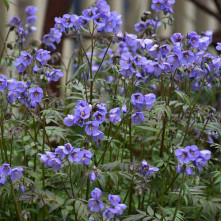 Heaven scent is a fragrant variety of Jacob’s Ladder and features purple-blue blossoms and attractive foliage throughout the spring and summer seasons. A native of moist shady southeastern Minnesota woodlands, it can perform spectacularly in a cool shady corner of almost any midwestern home garden.
Heaven scent is a fragrant variety of Jacob’s Ladder and features purple-blue blossoms and attractive foliage throughout the spring and summer seasons. A native of moist shady southeastern Minnesota woodlands, it can perform spectacularly in a cool shady corner of almost any midwestern home garden.
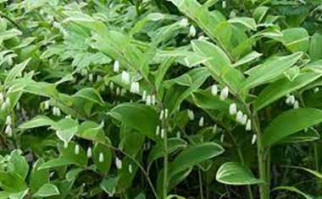 This is a cultivar produced by selective breeding of a native plant. It’s mellow green leaves are accented by creamy edges and set off the fragrant, graceful white bell-shaped blossoms. This plant is a classic for cool woodland gardens or to fill in shady borders. In the fall, the leaves turn attractive shades of yellow until you cut them back in late autumn.
This is a cultivar produced by selective breeding of a native plant. It’s mellow green leaves are accented by creamy edges and set off the fragrant, graceful white bell-shaped blossoms. This plant is a classic for cool woodland gardens or to fill in shady borders. In the fall, the leaves turn attractive shades of yellow until you cut them back in late autumn.
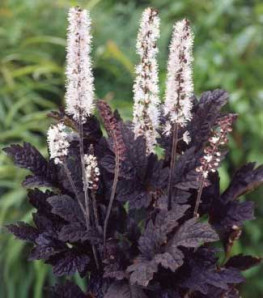 This local plant has it all! Tall, fragrant flowering spikes shaped like long tapered candles are set off by dark fern-like foliage, Cimcifuga comes in many varieties including this one called brunette. Its studding looks add drama to your garden and its resistance to deer and rabbits ensure its survival. It also provides late-season nectar for beneficial pollinators.
This local plant has it all! Tall, fragrant flowering spikes shaped like long tapered candles are set off by dark fern-like foliage, Cimcifuga comes in many varieties including this one called brunette. Its studding looks add drama to your garden and its resistance to deer and rabbits ensure its survival. It also provides late-season nectar for beneficial pollinators.
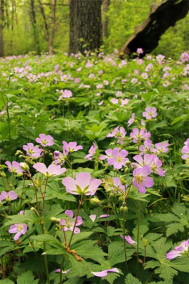 These lovely wildflowers are easy to grow in average, medium, well-drained soil both in full sun and partial shade — even if the soil is poor. A Missouri native, this woodland perennial typically grows in woods, thickets and shaded roadside areas. Its foliage reaches up to 24" tall and 18" wide and its blossoms are pink to lilac. The blossoms are saucer-shaped, 5-petal flowers in the spring and last for 6-7 weeks. After that, the flowers give way to distinctive, beaked seed capsules which inspired the common name of Crane's Bill.
These lovely wildflowers are easy to grow in average, medium, well-drained soil both in full sun and partial shade — even if the soil is poor. A Missouri native, this woodland perennial typically grows in woods, thickets and shaded roadside areas. Its foliage reaches up to 24" tall and 18" wide and its blossoms are pink to lilac. The blossoms are saucer-shaped, 5-petal flowers in the spring and last for 6-7 weeks. After that, the flowers give way to distinctive, beaked seed capsules which inspired the common name of Crane's Bill.
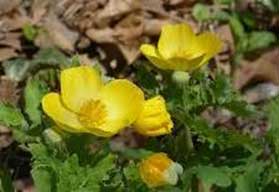 The brilliant hue of these graceful flowers will cheer up any garden. Their sunshine-yellow blooms have frilly centers and are set off by beautiful blue-green foliage. They make excellent ground cover and thrive in the shade. Native to Missouri, Wood Poppies grow in woodlands and along streambanks.
The brilliant hue of these graceful flowers will cheer up any garden. Their sunshine-yellow blooms have frilly centers and are set off by beautiful blue-green foliage. They make excellent ground cover and thrive in the shade. Native to Missouri, Wood Poppies grow in woodlands and along streambanks.
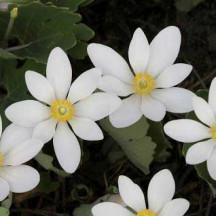 Bloodroot gets its name from the crimson sap that flows through its roots and stems. When the cigar-shaped leaves of the bloodroot completely unfurl, they open into foliage that resembles water lily pads. The Bloodroot’s pristine white flowers have golden-yellow centers that light up the garden floor with breathtaking springtime beauty. They are happiest planted in partial shade and moist soil.
Bloodroot gets its name from the crimson sap that flows through its roots and stems. When the cigar-shaped leaves of the bloodroot completely unfurl, they open into foliage that resembles water lily pads. The Bloodroot’s pristine white flowers have golden-yellow centers that light up the garden floor with breathtaking springtime beauty. They are happiest planted in partial shade and moist soil.
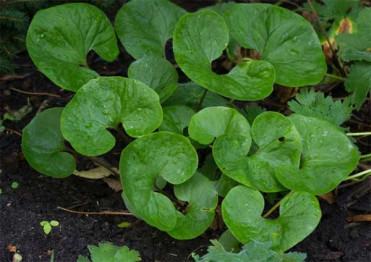 With dark green heart-shaped leaves that can grow up to 6 inches in diameter, Canadian Ginger can be found in moist, rich soils in the eastern forests. Its extremely hardy and makes an excellent ground cover. Deciduous, it seems to die in the winter but comes back to life again every spring, gracing your garden or yard with deep green leaves. The common name of Wild Ginger refers to the fact that when the stems and roots of the pant are crushed, they give off a strong aroma that resembles lemon ginger.
With dark green heart-shaped leaves that can grow up to 6 inches in diameter, Canadian Ginger can be found in moist, rich soils in the eastern forests. Its extremely hardy and makes an excellent ground cover. Deciduous, it seems to die in the winter but comes back to life again every spring, gracing your garden or yard with deep green leaves. The common name of Wild Ginger refers to the fact that when the stems and roots of the pant are crushed, they give off a strong aroma that resembles lemon ginger.
All of these native plants and cultivars do well in our part of the country and are relatively easy to care for. They add a lush, colorful beauty to gardens, backyards and neighboring woodlands, some in the spring or summer, others in the fall.
Call me at 847-912-6319 for more information on how you can incorporate them into your own landscaping.
Yours,
Curt
My interest in these plants first began when I majored in botany at Eastern Illinois University. I still have the textbook from that class and refer to it on occasion. Since my student days, I’ve collected and grown most of these flowers in my own yard. Here are some of my favorites that you might want for your garden too:
Aster Divaricatus also called White Wood Aster
 Graceful white daisy-like petals grow out from a golden center that butterflies just love. This plant grows well in dry to medium, well-drained soil in full or partial shade. Around 3’ feet in height with an upright habit and spreading branches, the flowers grow on slender stems often reddish in color. The dark colored stems contrast beautifully with the white flowers. These asters are the first to bloom in late summer but the deep green foliage looks great all season.
Graceful white daisy-like petals grow out from a golden center that butterflies just love. This plant grows well in dry to medium, well-drained soil in full or partial shade. Around 3’ feet in height with an upright habit and spreading branches, the flowers grow on slender stems often reddish in color. The dark colored stems contrast beautifully with the white flowers. These asters are the first to bloom in late summer but the deep green foliage looks great all season.Polemonium Reptans also called Jacob's Ladder
 Heaven scent is a fragrant variety of Jacob’s Ladder and features purple-blue blossoms and attractive foliage throughout the spring and summer seasons. A native of moist shady southeastern Minnesota woodlands, it can perform spectacularly in a cool shady corner of almost any midwestern home garden.
Heaven scent is a fragrant variety of Jacob’s Ladder and features purple-blue blossoms and attractive foliage throughout the spring and summer seasons. A native of moist shady southeastern Minnesota woodlands, it can perform spectacularly in a cool shady corner of almost any midwestern home garden.Polygonatum Variegatum also called Solomon's Seal
 This is a cultivar produced by selective breeding of a native plant. It’s mellow green leaves are accented by creamy edges and set off the fragrant, graceful white bell-shaped blossoms. This plant is a classic for cool woodland gardens or to fill in shady borders. In the fall, the leaves turn attractive shades of yellow until you cut them back in late autumn.
This is a cultivar produced by selective breeding of a native plant. It’s mellow green leaves are accented by creamy edges and set off the fragrant, graceful white bell-shaped blossoms. This plant is a classic for cool woodland gardens or to fill in shady borders. In the fall, the leaves turn attractive shades of yellow until you cut them back in late autumn.Cimcifuga also called Bugbane or Actaea
 This local plant has it all! Tall, fragrant flowering spikes shaped like long tapered candles are set off by dark fern-like foliage, Cimcifuga comes in many varieties including this one called brunette. Its studding looks add drama to your garden and its resistance to deer and rabbits ensure its survival. It also provides late-season nectar for beneficial pollinators.
This local plant has it all! Tall, fragrant flowering spikes shaped like long tapered candles are set off by dark fern-like foliage, Cimcifuga comes in many varieties including this one called brunette. Its studding looks add drama to your garden and its resistance to deer and rabbits ensure its survival. It also provides late-season nectar for beneficial pollinators.Geranium Maculatum also called Crane’s Bill
 These lovely wildflowers are easy to grow in average, medium, well-drained soil both in full sun and partial shade — even if the soil is poor. A Missouri native, this woodland perennial typically grows in woods, thickets and shaded roadside areas. Its foliage reaches up to 24" tall and 18" wide and its blossoms are pink to lilac. The blossoms are saucer-shaped, 5-petal flowers in the spring and last for 6-7 weeks. After that, the flowers give way to distinctive, beaked seed capsules which inspired the common name of Crane's Bill.
These lovely wildflowers are easy to grow in average, medium, well-drained soil both in full sun and partial shade — even if the soil is poor. A Missouri native, this woodland perennial typically grows in woods, thickets and shaded roadside areas. Its foliage reaches up to 24" tall and 18" wide and its blossoms are pink to lilac. The blossoms are saucer-shaped, 5-petal flowers in the spring and last for 6-7 weeks. After that, the flowers give way to distinctive, beaked seed capsules which inspired the common name of Crane's Bill.Stylophorum also called Celandine Poppy or Wood Poppy
 The brilliant hue of these graceful flowers will cheer up any garden. Their sunshine-yellow blooms have frilly centers and are set off by beautiful blue-green foliage. They make excellent ground cover and thrive in the shade. Native to Missouri, Wood Poppies grow in woodlands and along streambanks.
The brilliant hue of these graceful flowers will cheer up any garden. Their sunshine-yellow blooms have frilly centers and are set off by beautiful blue-green foliage. They make excellent ground cover and thrive in the shade. Native to Missouri, Wood Poppies grow in woodlands and along streambanks.Bloodroot
 Bloodroot gets its name from the crimson sap that flows through its roots and stems. When the cigar-shaped leaves of the bloodroot completely unfurl, they open into foliage that resembles water lily pads. The Bloodroot’s pristine white flowers have golden-yellow centers that light up the garden floor with breathtaking springtime beauty. They are happiest planted in partial shade and moist soil.
Bloodroot gets its name from the crimson sap that flows through its roots and stems. When the cigar-shaped leaves of the bloodroot completely unfurl, they open into foliage that resembles water lily pads. The Bloodroot’s pristine white flowers have golden-yellow centers that light up the garden floor with breathtaking springtime beauty. They are happiest planted in partial shade and moist soil.Canadian Wild Ginger
 With dark green heart-shaped leaves that can grow up to 6 inches in diameter, Canadian Ginger can be found in moist, rich soils in the eastern forests. Its extremely hardy and makes an excellent ground cover. Deciduous, it seems to die in the winter but comes back to life again every spring, gracing your garden or yard with deep green leaves. The common name of Wild Ginger refers to the fact that when the stems and roots of the pant are crushed, they give off a strong aroma that resembles lemon ginger.
With dark green heart-shaped leaves that can grow up to 6 inches in diameter, Canadian Ginger can be found in moist, rich soils in the eastern forests. Its extremely hardy and makes an excellent ground cover. Deciduous, it seems to die in the winter but comes back to life again every spring, gracing your garden or yard with deep green leaves. The common name of Wild Ginger refers to the fact that when the stems and roots of the pant are crushed, they give off a strong aroma that resembles lemon ginger.All of these native plants and cultivars do well in our part of the country and are relatively easy to care for. They add a lush, colorful beauty to gardens, backyards and neighboring woodlands, some in the spring or summer, others in the fall.
Call me at 847-912-6319 for more information on how you can incorporate them into your own landscaping.
Yours,
Curt




